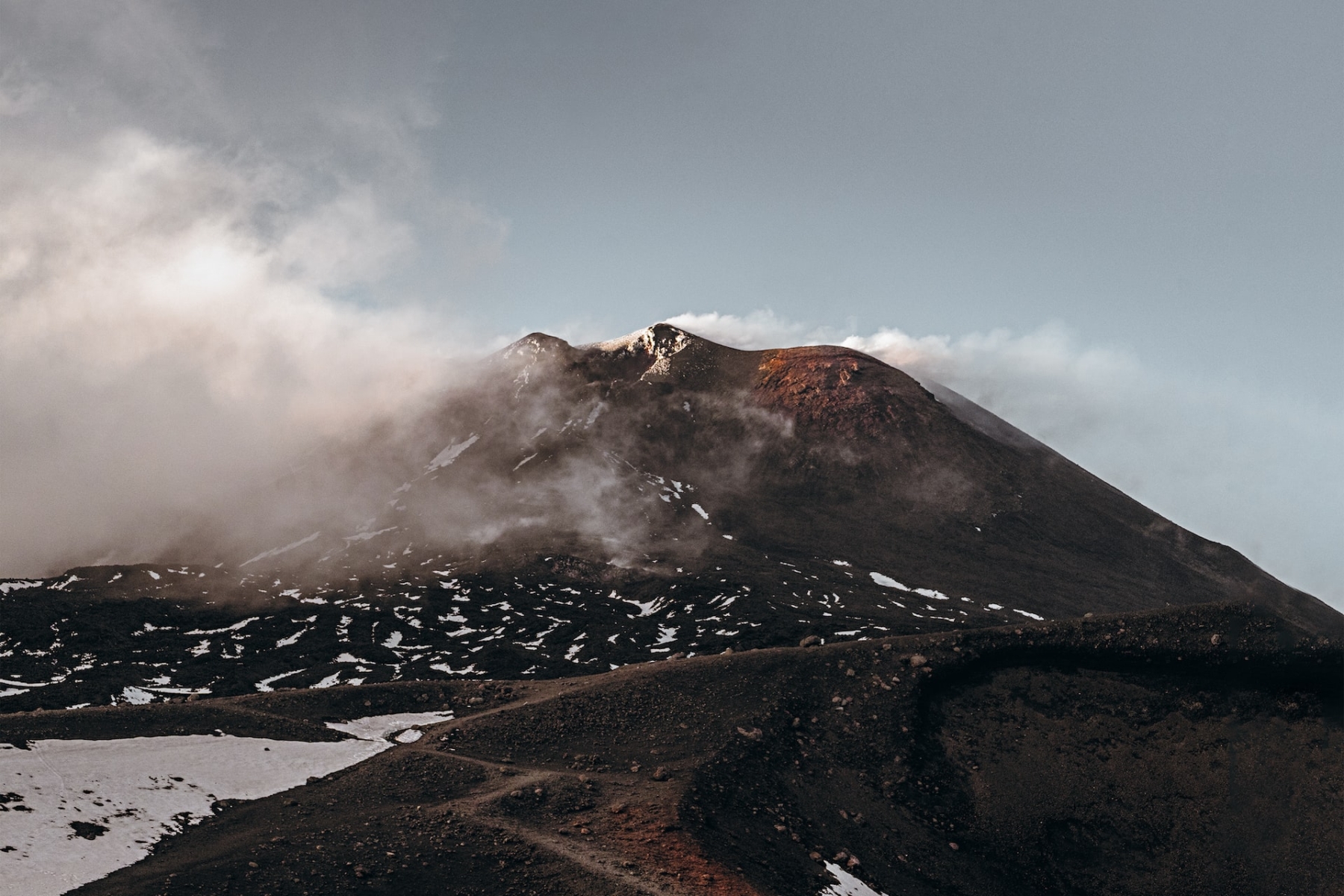One of the world’s most active volcanoes is also a fascinating wine region. Etna wines are among the finest in Italy. Long history, unique terroir and resourceful winemakers are the ingredients of Etna’s success. Do you want to know more? I explore the vinous wonders of Mount Etna in a two-part series
In this article, I focus on Etna’s history, grape varieties, appellations and terroir. For the second part of this series, I will share details of the wonderful Etna wines I have enjoyed over the years. My tasting notes will give you a glimpse of what this extraordinary wine region has to offer.
Let’s start the journey….
Mount Etna (affectionately called “a Muntagna” – the Mountain – by locals) is an active volcano located near the northeast coast of Sicily, in southern Italy. The nearest big city is Catania, 35 kilometres away.
Mount Etna is a distinctive landmark in Sicily due to its towering presence (3330 metres of altitude) and turbulent energy – it’s the most active volcano in Europe. Sometimes Etna mountain is so quiet that the only visible signs of its geothermal activities are the constant whiffs of white smoke from its craters. Other times a thick fog of ashes and sulphurous exhalations cover the volcano’s flanks. An ominous outlook akin to Sauron’s Mount Doom in a J.R.R. Tolkien setting. Regardless of its state, the volcano always has a looming demeanour as it casts an almost god-like presence over the surrounding areas.
Mount Etna’s legends
The capricious peak has never ceased to impress the people living in its shadow. In fact, not many vineyards on Earth are imbued with legends and folklore like Mount Etna.

In ancient times, people believed that the god Zeus (ruler of the Greek pantheon) trapped the deadly monster Typhon under the Etna mountain. While in another Greek legend, the forges of Hephaestus (god of blacksmiths and fire) lay beneath the volcano. It was thought the glooming smoke puffing out of Etna’s crater signified that the god was sweating down there.
There is a mediaeval tale where Mount Etna is described as the realm of King Arthur and his half-sister Morgan. A more recent English myth suggests that Queen Elizabeth I inhabited the dungeons beneath the volcano due to a deal she made with the devil to rule her kingdom.
An ancient history
Ancient Greeks brought viticulture to the slopes of Mount Etna when they colonised Sicily in the 6th century BC. At that time, the areas near Etna and Catania produced highly praised wines. During Roman domination, Etna’s vineyards increased in size as their wines were held in esteem among the sophisticated Roman elite.
Albeit with some ups and downs, Etna’s viticultural success continued throughout the Middle Ages and Renaissance. However, the beginning of the 20th century marked a serious crisis for Sicily and Etna. The phylloxera havoc (which caused the destruction of around 80% of the vines in Europe) and the frequent eruptions of the Etna volcano dramatically reduced wine production.
In the second half of the 20th century, Etna viticulture began to grow again. The first Etna DOC was created in 1968, but it took another couple of decades before this area was recognised by the wine world. According to legend, Giuseppe Benanti in the early 1990s was outraged by drinking a glass of poor local rosso. He decided that the area could produce better wine. The Benanti winery and a few other enlightened viticulturists helped bring the Etna region international acclaim. Throughout the 1990s and 2000s Italian and foreign vignerons such as the local guru Salvo Foti, the Belgian purist Frank Cornelissen, the US importer Marc De Grazia, Tuscany’s Andrea Franchetti and the local Tasca d’Almerita all committed to keeping Etna’s reputation high throughout the world.

The appellations
Now let’s delve into more geeky vinous details. The Etna area boasts seven DOC (Denominazione di Origine Controllata) appellations.
The two red denominations are Etna Rosso DOC and Etna Rosso Riserva DOC. Both require a minimum of 80% Nerello Mascalese and up to 20% of Nerello Cappuccio. As an additional requirement, Etna Rosso Riserva must be aged a minimum of 4 years – one of which must be in wooden vessels.
For whites, the principal appellation is Etna Bianco DOC, containing at least 60% of Carricante in the blend by law. The more stringent Etna Bianco Superiore DOC dictates the minimum percentage of Carricante grape to be 80%. Furthermore, Etna Bianco Superiore DOC can be only produced in a restricted area near Milo. In both white DOCs, the remaining part of the blend has to be from some of the selected local varieties such as Catarratto, Minella, Grecanico, Trebbiano, Insolia.
Other, less widespread, appellations include Etna Rosato DOC (for still rose – requiring a minimum of 80% of Nerello Mascalese), Etna Spumante Rosato DOC (for sparkling rose wines) and Etna Spumante Bianco DOC (for sparkling whites). The last two DOCs demand a minimum of 60% of Nerello Mascalese in the bottle.
The Etna DOC system also allows the use of contrade. From a practical point of view, a contrada is a sub-zone or commune in the Etna area. If a wine is labelled with a specific contrada, it means that the grapes are sourced exclusively from that zone.
The concept of contrada is comparable to the French crus or Barolo MGAs. A contrada defines a specific terroir which confers unique characteristics to the wines produced in the area. There are currently 133 contrade in the Etna DOC system, each one differing in size and renown.

Paul Asman and Jill Lenoble
Etna wine grapes
The red wines of Etna are dominated by two Nerello grapes: Nerello Mascalese and Nerello Cappuccio. Without a doubt, Nerello Mascalese is the more refined grape, bringing aromas of perfumed red cherry, earth, game meat and herbal notes. Nerello Mascalese also has a good structure and elegant presence thanks to its high acidity and firm tannins.
Nerello Cappuccio is somehow more rustic, with less refined tannins, rounder and richer in colour. As a blending partner in the Etna red wines, Nerello Cappuccio is often used to soften out some of Mascalese’s sharper edges.
From a stylistic standpoint, in their best incarnations, Etna Rosso wines sit between Burgundy and Barolo. Several critics highlighted the similarities between Etna Rosso and French Pinot Noir: pale ruby hue, earthy nuances, high acidity and refined red fruit profile. Nebbiolo offers another natural comparison; it shares with the Nerello brothers high acidity and tannins, liquorice and herbal notes and imposing structure. In both cases, these highly regarded analogies imply that the Nerello blends can achieve great elegance and refinement. As such, Etna Rosso has nothing to fear from the comparison between it and the more famous Italian noble wines.
By far the most interesting white-skinned grape variety in the Etna district is Carricante. This noble grape variety is indigenous to the area and can be only found on the slopes of the Etna mountain. Wines made from Carricante are capable of amazing complexity and remarkable longevity. Carricante-led blends can be lean and crisp, sharing some similarities with sauvignon blanc, or more full-bodied and creamy with riper fruit aromas. Generally, all styles of Carricante wines have a fresh acidity and a distinctive savoury note.
The best examples of Carricante-based wines resemble top Alsatian rieslings. They have generous fruit notes, impeccable flinty minerality and possess a great ability to age in the bottle. Over time, Carricante-based wines develop honeyed and spicy notes, as well as hints of petrol intertwined with sweet suggestions.
Alas, not all Etna Bianco wines are born equal. Etna Bianco DOC regulations are less stringent than their red counterparts, allowing up to 40% of less noble grapes in the blend (for example, Catarratto, Minella, Grecanico and Trebbiano). As a result, quality varies a lot and it’s important to know reliable producers if you want to drink a great Etna Bianco.
In comparison, Etna Bianco Superiore DOC has more stylistic consistency and in general maintains higher standards. All the Etna Bianco Superiore wines I drank were superb and worth the extra coin.
In both red and white wines, the use of oak (especially new) is restrained. Etna wines have a strong aromatic profile, therefore they don’t need to rely on the addition of oak. In fact, oftentimes wood use is seen as detrimental. Etna wines are generally vinified either in stainless steel vessels or large old “botti” as these almost neutral vessels impart little flavour on their own.

Etna’s terroir
Etna’s unique terroir is a key factor affecting the wines produced there. While Sicily has a Mediterranean climate, with mild winters and scorching sunny summers, Etna’s microclimate is different. It’s more continental, with Etna’s high altitude and strong winds having a defining role.
Etna’s microclimate allows grape berries to achieve good phenolic ripeness, with plenty of sugar and flavours thanks to sunny days. The altitude ensures the temperature is never so extreme that it withers grapes. Furthermore, elevation means higher diurnal temperature excursion, which is highly beneficial for the vines. The ripening process is slower and more even; more complex flavours develop while preserving a high fresh acidity.
Viticulture on slopes also means optimal drainage and better air circulation – all factors that improve the overall grape quality. Unfortunately, the flip side of the coin is that vineyards on slopes are more difficult to cultivate. Mechanisation is limited and intense hand labour is required.
Another distinguishing feature of Etna’s terroir lies in its volcanic soil. For some reason, volcanic terrains always produce mesmerising wines with a distinctive minerality. It is as if the characteristics of the black soil are somehow inherited by the grapes and transferred to the wine. I’d like to point out that this is not the case in reality. The relation between soil and wine is much more complicated, as I explained in this article.
The volcanic soil in Etna ensures optimal drainage, while the ashes contain nutrients that are a real treat for vines: magnesium, phosphorus, iron and potassium. Further, the soil is periodically enriched by the volcanic ash clouds floating around the area. These clouds bring tiny lapillus and ash fragments – a mix locally known with the term “ripiddu”, enthusiastically welcomed by winemakers!

Old vines are common in Etna vineyards. Another reason for vignerons to get excited! Even though old vines generally produce less fruit (and as such smaller quantities of wine), the flavours in their grapes are concentrated and the aromas are dense and rich. Truly luscious in the glass!
The local vine-training system (called “alberello”) completes the picture of the Etna’s typical terroir. The alberello style is a three-thousand-year-old tradition. The vines are bush-trained and grow around a vertical pole of chestnut wood, like a tree (“alberello” means “little tree” in Italian). The plant grows quite low, protruding from the ground in an inverted cone shape. The close proximity to the ground allows heat absorption from the warm soil, helping the ripening of the fruit. The open shape of the canopy on the top improves aeration and light exposure for the vine. The overall result is a healthier plant and generally a better wine.
What’s next
In this first part of my series dedicated to the Mount Etna wines, I illustrated the unique character of the land. Etna’s history, grape varieties, DOC appellations and terroir are important factors to understand the wines from this region.
In the next and final chapter of the Mount Etna wine series, I will present my readers with some Etna wines I sipped and loved over the last few years. After all, don’t you want to know why these wines have been praised over the past few millennia?

